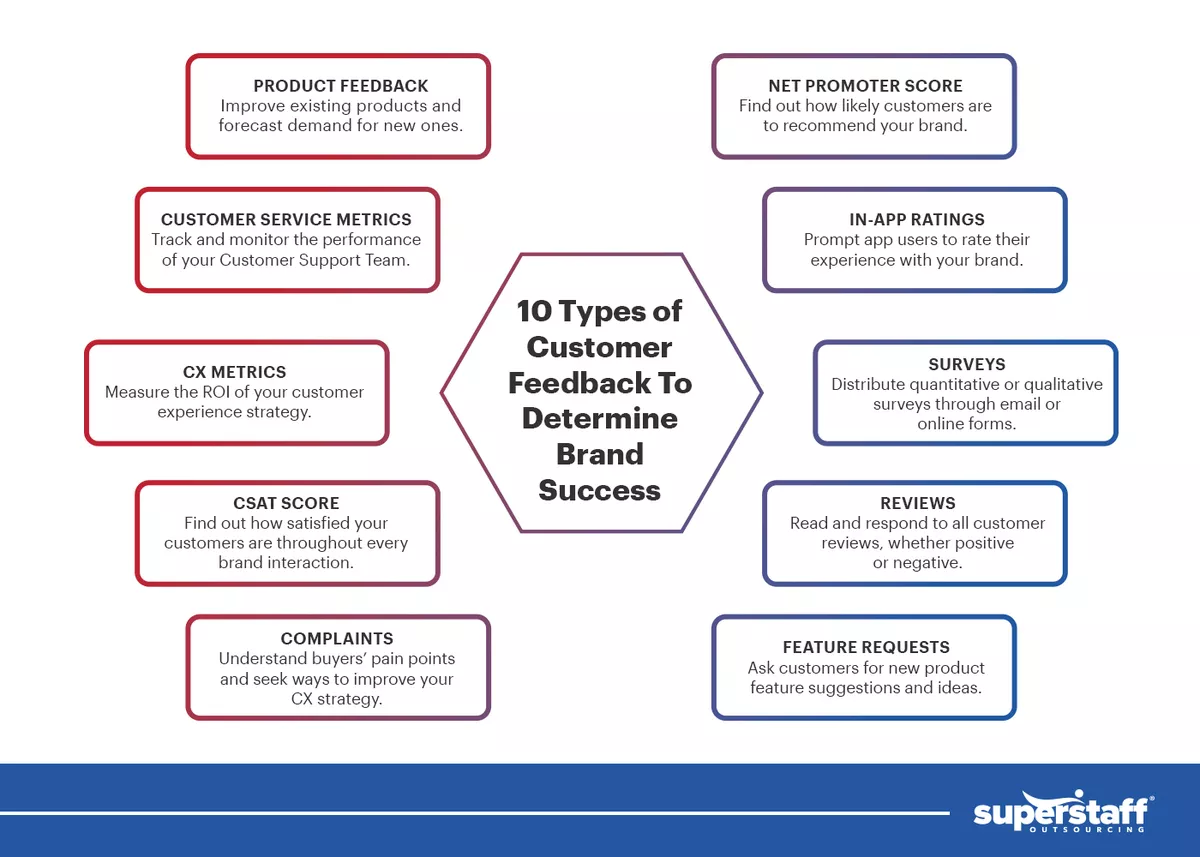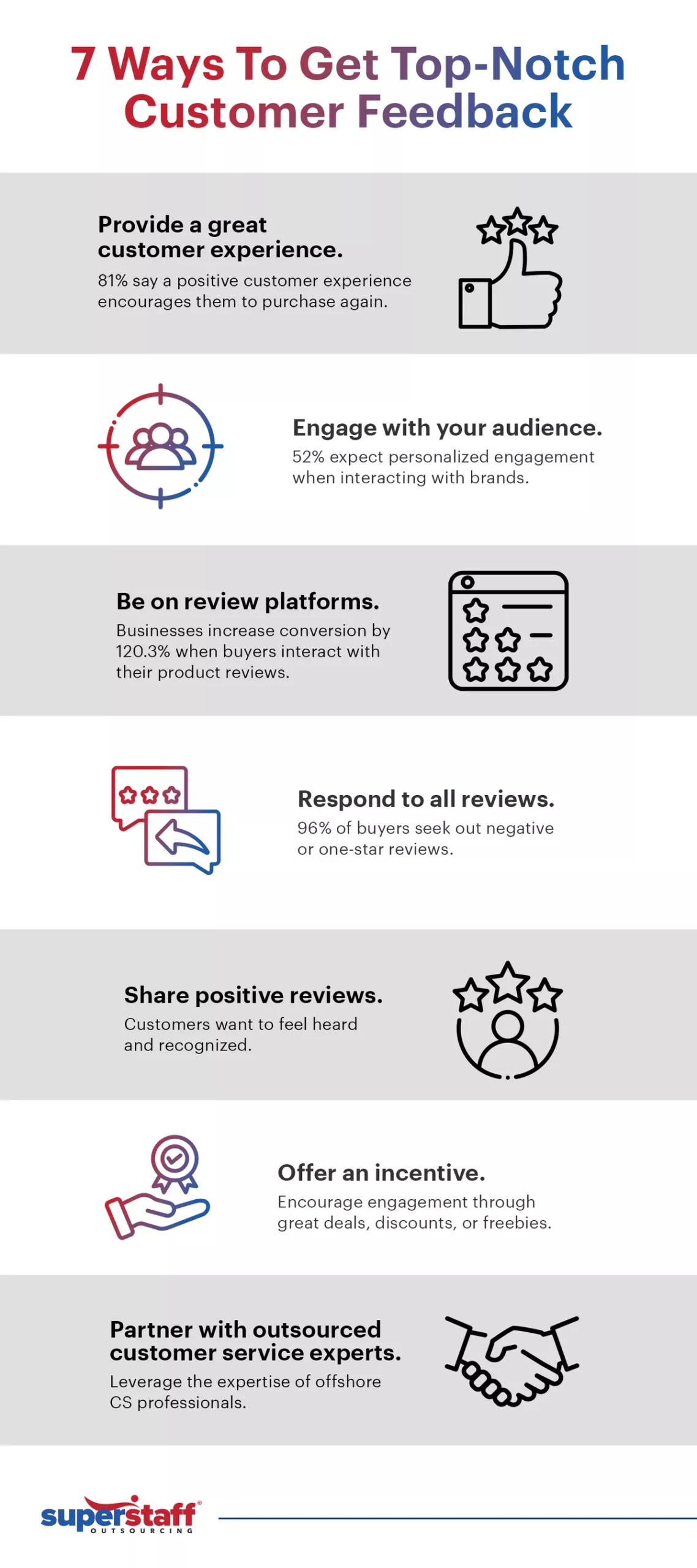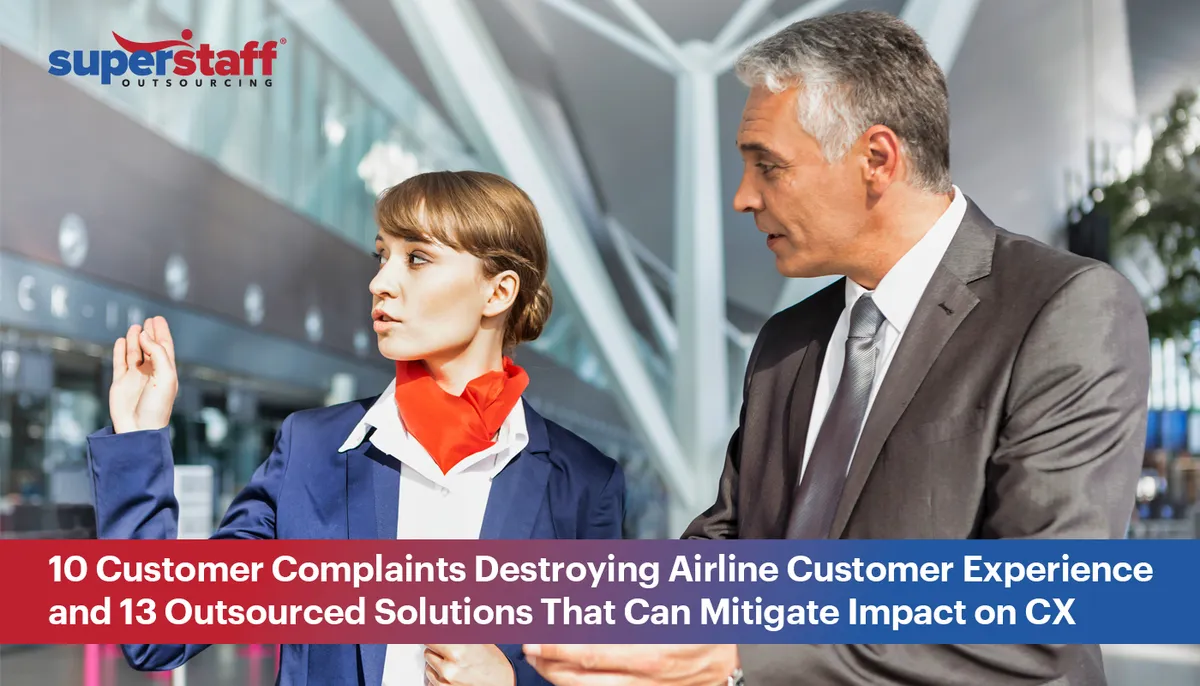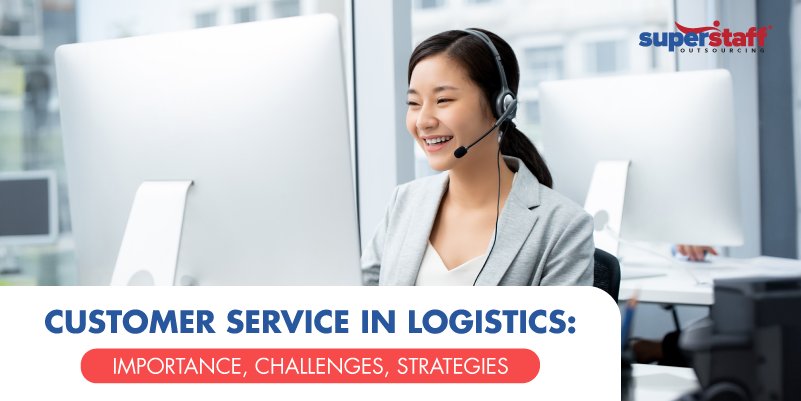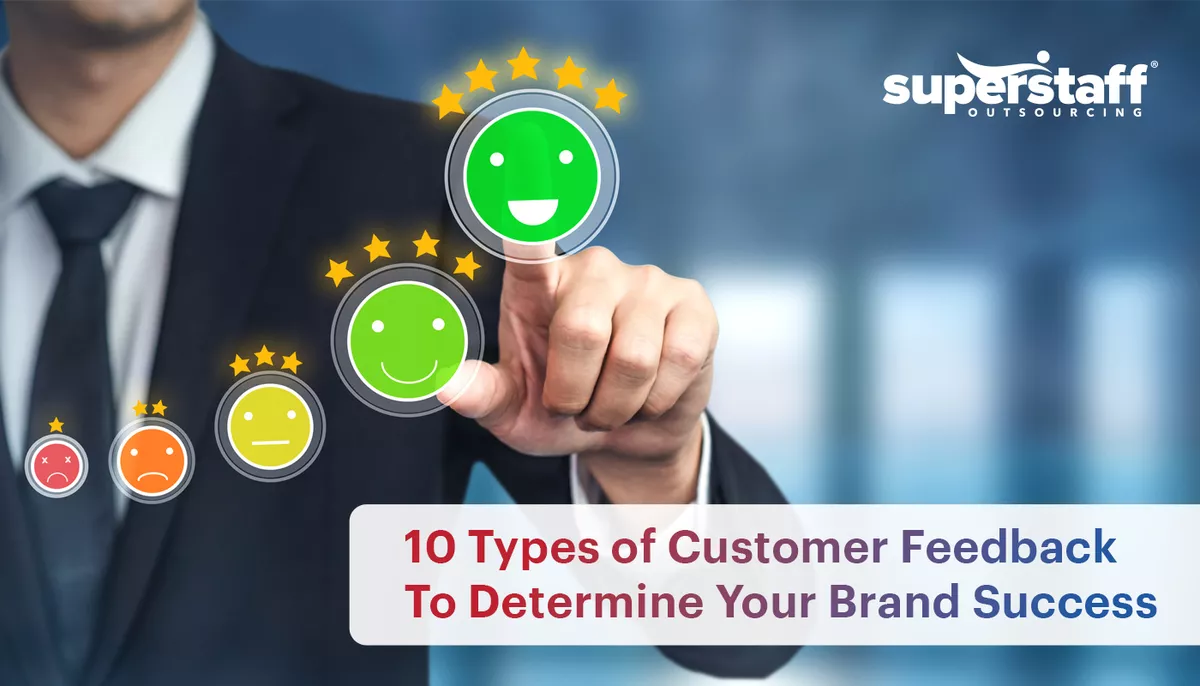
If customer service is the lifeblood of your business, then customer feedback must be the arteries and veins keeping the blood flow running smoothly.
As the adage goes, “The customer knows best.” Brands must never assume they already know what their target consumers want. Instead, they should ask about their needs and listen to what they have to say through customer feedback.
Without a strong client feedback loop, you can never be sure whether your customer service efforts are effective or your approach needs further improvement.
Think about it: How will you know what you’re doing wrong unless your customer directly tells you? Similarly, how will you know what you’re doing right unless you ask?
Think of feedback as a gold mine for valuable customer insights that help you better understand your target market’s pain points, improve your product or service, and shape your brand’s future.
Your Guide to Collecting Customer Feedback: Top 10 Most Common Types
Over the past decade, businesses of all industries have utilized various metrics to collect, measure, and analyze customer feedback. Chances are high that your company has already used one or more of these to build better relationships with customers and win their trust and loyalty.
Businesses can collect several types of customer feedback to improve their products and services. Here are some of them:
Product Feedback
Getting feedback on your products is a vital part of the design and development process, allowing companies, particularly in the technology or consumer electronics industries, to understand which products customers like best and least. Through feedback surveys, buyers can rate a product’s features, design, and functionality or provide helpful comments about their experiences.
Brands can use the collected data to make product improvements, forecast demand for future products, and fix problems for current ones. At the same time, customers who answer product feedback surveys can also gain a valuable learning experience, helping them learn to think critically about their purchases and how to choose the best products.
Customer Service Metrics
Besides rating products, consumers can provide feedback on your customer support team’s performance. By measuring the quality of your customer service, you can keep track of best practices, assess which areas of your strategy need improvement, and find ways to innovate and enhance your processes.
Companies can track the performance of their customer service agents by setting relevant key performance indicators (KPIs), such as:
- Average Speed of Answer: Measures the average time it takes for a customer service agent to answer a call
- Average Handle Time: Tracks the average time starting when a call center agent picks up the phone until the call is disconnected
- First Call Resolutions: Monitors how often an agent resolves a client’s problem without returning, transferring, or escalating the call
- Average Call Abandonment Rate: Shows how many callers hang up the phone without reaching a service representative
You can also gain more detailed feedback by using automated survey tools to email recent callers. The survey can include questions about their experience, including how friendly and helpful your agents were or whether they feel their concern was handled appropriately and effectively.
Customer Experience Metrics
Collecting data about customer service quality is not enough. Today’s companies must also keep track of and measure their buyers’ overall experience across all relevant touchpoints.
After all, you shouldn’t wait for customers to provide feedback only when they’re already angry or frustrated. Having a quality customer experience (CX) strategy means being proactive in ensuring each step of the buyer’s journey is seamless, hassle-free, and positive for everyone.
For tracking the overall ROI of customer experience, businesses can use metrics like:
- Customer Lifetime Value: Quantifies the total value customers bring to your company throughout their entire engagement
- Customer Health Score (CHS): Evaluates potential issues or opportunities with a customer
- Customer Effort Score (CES): Determines how easy (or difficult) it is for customers to complete a transaction or resolve an issue with your business
Customer Satisfaction Score
The more satisfied the customer is with your brand, the more likely they will remain loyal and continue doing business with you. Satisfaction is not limited to customer service and involves the entire customer journey, from when they first discover your products or services to when they make a purchase.
One specific metric businesses use is the Customer Satisfaction (CSAT) score. It measures customer satisfaction (meaning you are meeting their expectations and effectively keeping them happy and interested in your brand) by answering a series of questions, each with a sliding scale ranging from “very dissatisfied” to “very satisfied.”
Complaints
Businesses shouldn’t expect only positive feedback. They must also gauge overall customer sentiment by paying attention to customers’ negative experiences, which helps them better understand buyers’ pain points and identify potential weaknesses in their CX strategy.
Customers can send complaints through various platforms, including phone calls, online reviews, emails, or social media comments. Ideally, your customer care department should have a record of all complaints, highlighting recurring issues and making action plans to improve service delivery.
Proactive businesses may also provide a more structured way for people to log complaints, such as a customer feedback platform, an online ticketing system, a complaint form, or a community forum. Promptly responding to and addressing complaints can help companies improve client satisfaction and prevent churn.
Net Promoter Score (NPS)
Beyond one customer’s personal satisfaction, another way to determine how much they like your brand is by asking whether they’re willing to recommend you to their family, friends, and loved ones. Net Promoter Scores (NPS) include a standardized customer feedback questionnaire measuring this.
NPS asks customers about their likelihood of recommending a brand to a friend or colleague. A higher score (9 to 10) means that the person perceives your brand positively and will happily promote your products or services.
Meanwhile, a mediocre score (between 7 to 8) means they are satisfied but unlikely to recommend you, and a low score (between 0 to 6) signifies overall dissatisfaction.
Word-of-mouth is a powerful marketing tool, often more persuasive than traditional advertising methods, so improving your NPS score can do wonders for your brand’s success.
In-App Ratings
For businesses that have developed branded mobile applications, tracking user feedback through in-app ratings can also help measure customer satisfaction. Be proactive in asking for feedback by prompting users to rate their experience after finishing a specific action.
For example, e-commerce apps may ask customers to rate their experience after receiving their items (length of delivery time or ease of contact with the seller). Meanwhile, banking apps may ask for feedback after completing a transaction.
Customer Feedback Surveys
Surveys are among the most common and easiest ways to get to know your customers. These structured questionnaires, often involving “yes or no” questions, multiple choices, or sliding scales, are distributed via email, websites, or social media platforms. They are a convenient way to collect quantitative data about customer experiences.
Some typical customer satisfaction survey questions include:
- How would you rate our products or services on a scale of 1 to 10?
- Are you satisfied with your customer service experience? Yes or no.
- Which of the following words best describes your experience with our company?
- Would you recommend our brand to your friends?
At times, companies may also add open-ended questions to the survey (for example, “What else would you recommend to our customer service team?”), so that consumers can more freely speak their minds or offer detailed feedback.
Although surveys are generally sent through email to existing customers, companies can also use different channels, such as social media, online forms, or mobile apps. Some businesses also choose to conduct surveys in person, allowing them to gather real-time feedback and offer the chance for clarification or further discussion.
Customer Reviews
Online reviews are another well-known customer feedback tool, helping the business and potential consumers learn how an existing buyer feels about a particular brand. Customers often leave their comments on dedicated review websites, social media pages, or through apps.
Ideally, businesses would respond to each review, whether it’s positive or negative. Reading and addressing reviews can help companies manage their online reputation, show customers that they care about their feedback, and help new customers avoid past problems.
Feature Requests
Feature requests involve asking existing customers for feedback on particular products, especially seeking new ideas about improving them. This feedback method is particularly crucial for companies that offer digital products, electronic devices, or other items that benefit from continual innovation.
Suggestions for new features often signify a pain point for customers that you have yet to address, or they may simply need a quality-of-life improvement for greater convenience and ease of access. Not all feature requests are worth implementing, but brands must consider everything.
Collecting and analyzing all feedback is critical for improving products and services and keeping customers satisfied. You can ask for feature suggestions through various channels, such as surveys, in-app chats, and online reviews.
How To Get Feedback From Customers in 7 Simple Steps
In today’s fast-paced business landscape, the company that collects feedback and quickly acts on it has a distinct competitive advantage. Listening to what your customers want and need is the key to refining products, enhancing services, and, ultimately, driving growth.
Here are some best practices to encourage positive customer feedback:
Provide a great customer experience.
Many businesses want to hear from their target base but aren’t sure how to ask for feedback from customers. The best approach is to ensure you’re providing a great experience.
Remember: CX is not just about customer service; it involves all consumer interactions with your business, from discovery to purchase.
A Salesforce report found that consumers use an average of nine touchpoints when connecting with companies, with 60% of all interactions occurring online. Brands must proactively optimize all relevant CX touchpoints, preferably utilizing human-centered AI design to build stronger customer relationships.
When they do, they reap many rewards, cultivating a passionate and loyal consumer base while improving their bottom line.
Here are a few statistics proving the value of CX:
- 61% of customers are willing to pay 5% more for a better customer experience.
- Meanwhile, 60% switch brands after one negative CX interaction.
- 81% say a positive experience encourages them to make another purchase in the future.
- 64% of business leaders agree that an effective CX strategy impacts company growth.
Engage with your audience.
In addition to ensuring a positive customer experience, engaging with them is another excellent way to elicit positive reviews. According to Salesforce’s research, 52% of consumers expect personalized engagement when interacting with brands.
Before you even send out a customer feedback survey, make an effort to foster genuine connections with your target audience, engaging with them authentically to show that you genuinely care about and value what they say. Responding to customer queries, sharing great content, and having a solid social media strategy in place can all help encourage positive customer sentiments.
Ask buyers about their experiences, encourage them to share their points of view, and remember to treat each individual with unique needs and expectations.
Be on review platforms.
Reviews are essential for boosting a company’s online reputation. Recent studies have found that 99.9% of consumers read reviews before making purchases, and 98% consider them crucial for helping them make shopping decisions. Meanwhile, businesses experience a 120.3% increase in conversion when buyers interact with ratings and reviews of their products.
Customers will find it challenging to leave reviews if your company doesn’t have a visible online presence. List your business on review platforms like Yelp, Google My Business, and TripAdvisor. Having active accounts in these channels makes it easier for customers to send you their reviews and improve your word-of-mouth.
Read and reply to all reviews.
Once you’ve created an account on review platforms, the next step should be to address feedback as soon as it starts rolling in.
Some may be tempted to ignore negative reviews, but this approach can cause even more friction between you and your customers. According to the research above, 96% of buyers seek out negative or one-star reviews, so disregarding these will affect how many people see your brand.
Responding to all reviews, even less-than-positive ones, shows that you care about your customers and are committed to improving their experience. Be polite, tactful, and, most of all, genuinely helpful when crafting replies, defusing situations before they escalate, and sometimes even winning back customers who may have turned away.
Share positive reviews.
Sometimes, all customers want is to feel heard and recognized. Let them know how much you value their input by featuring the best reviews on your website and social media pages.
Highlighting positive customer reviews on your website and in marketing emails can offer double value for your business: creating social proof and incentivizing other customers to leave a review.
Offer an incentive.
Suppose you’re struggling to think of how to collect customer feedback. In that case, another strategy is to offer incentives, such as great deals, discounts, or freebies, to encourage more buyers to leave a review. Remember that your goal is not to game the system but to show appreciation for reviewers and reward them for their loyalty.
Partner with outsourced customer service experts.
Working with offshore customer service experts is a strategic move to enhance customer support and garner positive feedback. This involves setting clear goals, selecting a reliable partner, providing comprehensive training, and establishing effective communication channels. Defining Service Level Agreements (SLAs) and implementing quality assurance measures are crucial for maintaining high standards.
Cultivating a customer-centric culture, leveraging technology, and integrating AI-powered solutions further optimize the customer experience. This partnership can significantly elevate customer support operations through careful planning and collaboration and lead to positive customer feedback.
Beyond helping you collect data, BPO providers can also offer customer feedback analysis. The right outsourcing partner can connect you with experienced data science professionals who can extract actionable insights from raw information, helping you make smarter choices for your CX strategy.
Collect Customer Feedback To Level Up Your Client Care Strategy
By elevating customer support, you’re not just resolving issues but creating memorable experiences that leave a lasting impression on your valued clientele.
With SuperStaff, a leading BPO firm offering world-class customer service solutions, you can start leveling up your CX strategy. Our team can help you gather and analyze customer feedback, leveraging data to foster innovation while utilizing the human element of customer service to build better client relationships.
In a world where customer experience reigns supreme, this strategic move can set your brand apart, earning you satisfied customers and loyal advocates. Embrace the power of outsourcing, and watch as your brand’s reputation soars to new heights.

